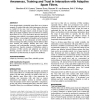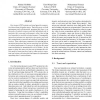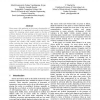8655 search results - page 142 / 1731 » Challenges for Trusted Computing |
CHI
2009
ACM
15 years 4 months ago
2009
ACM
Even though adaptive (trainable) spam filters are a common example of systems that make (semi-)autonomous decisions on behalf of the user, trust in these filters has been underexp...
ICDCSW
2006
IEEE
15 years 4 months ago
2006
IEEE
Peer-to-peer (P2P) systems are based upon the cooperative interactions of member peers. Typically, peers are both autonomous and self-interested, meaning that there is no hierarch...
111
click to vote
DSN
2005
IEEE
15 years 3 months ago
2005
IEEE
Since sensor data gathering is the primary functionality of sensor networks, it is important to provide a fault tolerant method for reasoning about sensed events in the face of ar...
NCA
2005
IEEE
15 years 3 months ago
2005
IEEE
In distributed P2P environments, peers (i.e., users) often have to request the services from some unfamiliar peers (i.e., resources) that could be altruistic, selfish, or even ma...
CHI
2010
ACM
14 years 8 months ago
2010
ACM
Mobile services can provide users with information relevant to their current circumstances. Distant services in turn can acquire local information from people in an area of intere...



